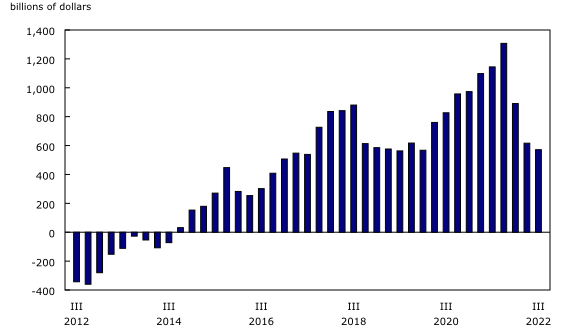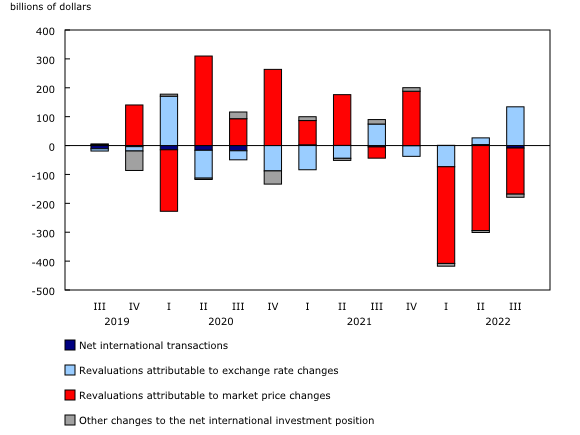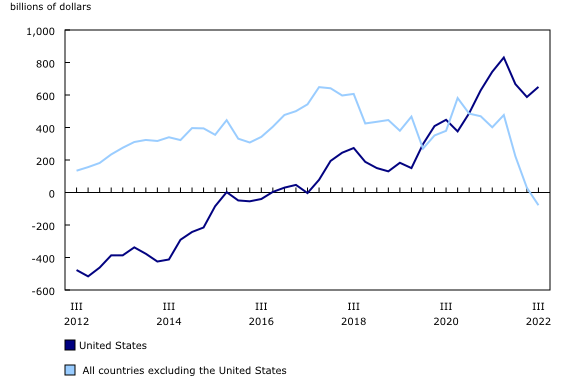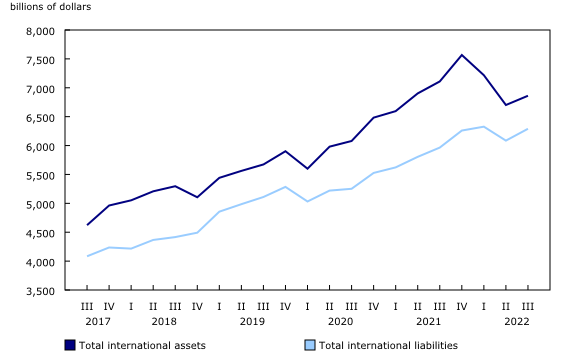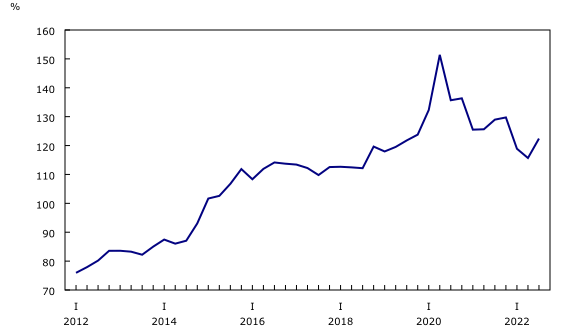Canada's international investment position, third quarter 2022
Released: 2022-12-09
$571.5 billion
Third quarter 2022
Canada's International Investment Position, third quarter 2022
Canada's net foreign asset position, the difference between Canada's international financial assets and international liabilities, was down by $44.9 billion to $571.5 billion at the end of the third quarter, its lowest level since the first quarter of 2020. This marked the third consecutive quarterly decline, as global equity markets continued a downward trend. In comparison, Canada's net foreign asset position stood at $1,307.4 billion at the end of 2021.
Overall, changes in market prices led to a $159.5 billion decrease in Canada's net foreign asset position. Canada's international assets and liabilities are highly exposed to equity market performance, as 62.5% of Canada's international assets and 41.3% of its liabilities were held in the form of equities at the end of the third quarter. Over the quarter, the US stock market declined 5.3%, while the Canadian stock market decreased 2.2%.
The revaluation effect from fluctuations in exchange rates (+$134.1 billion) moderated the overall decrease in Canada's net foreign asset position. The Canadian dollar lost 6.0% against the US dollar over the quarter, but gained 3.8% against the UK pound sterling, 0.6% against the euro and 0.1% against the Japanese yen. At the end of the third quarter, 96.2% of Canada's international assets were denominated in foreign currencies, compared with 41.5% of its international liabilities.
Canada's net foreign asset position can be expressed as a proportion of the gross domestic product (GDP), to illustrate its importance relative to the size of the economy. This ratio stood at 20.3% at the end of the third quarter. This proportion has decreased significantly since the fourth quarter of 2021, on weakened foreign equity prices.
Excluding the United States, Canada is a net borrower from the rest of the world
On a geographical basis, Canada's net asset position with the United States was up $62.2 billion to $649.8 billion at the end of the third quarter. The upward revaluation of US dollar-denominated instruments resulting from the depreciation of the Canadian dollar against its US counterpart largely contributed to this increase. The net asset position has declined by $180.9 billion since the beginning of 2022.
Excluding the United States, Canada became a net borrower from the rest of the world at the end of the third quarter. Canada posted a net foreign liability position of $78.3 billion with the rest of the world, compared with a net asset position of $28.7 billion in the previous quarter. The net position has lost over half a trillion dollar since the beginning of the year, down from a net asset position of $476.7 billion at the end of 2021.
As opposed to the net position with the US, which benefited from a weaker Canadian dollar in the context of declining global market prices, the stronger Canadian dollar, notably against the euro and the UK pound, contributed to further reduce the value of non-US assets over the period.
Canada's international liabilities rise more than assets
Canada's international assets were up by $160.2 billion (+2.3%) to $6,861.9 billion at the end of the third quarter. The upward revaluation attributable to exchange rate changes (+$254.7 billion) as well as substantial acquisitions of foreign assets (+$91.5 billion) led the growth. The downward revaluation (-$260.7 billion) resulting from fluctuations in market prices moderated the overall growth.
On the other side of the ledger, Canada's international liabilities amounted to $6,290.4 billion, an increase of $205.0 billion (+3.3%). The increase was primarily the result of the revaluation due to exchange rate movements (+$120.6 billion). Significant foreign borrowing activity (+$100.2 billion), mainly in the form of currency and deposits, as well as Canadian bonds, also contributed to the increase. However, the downward revaluation (-$101.3 billion) resulting from the fluctuations in market prices of both equity and debt instruments moderated the overall growth.
Canada's gross external debt increases
Canada's gross external debt, or the value of Canadian debt instruments held by foreign investors, was up by $166.9 billion to $3,441.1 billion at the end of the third quarter. It amounted to 122.4% of GDP.
The growth in the quarter largely originated from the financial sector, led by deposit-taking corporations. Gross external debt of this sector stood at $2,100.5 billion and represented the highest proportion of Canada's gross external debt at the end of September. Gross external debt of the government sector fell by $7.5 billion to $594.3 billion, its lowest level since the first quarter of 2021.
Note to readers
This release includes new data on financial derivatives. Starting from 2019, international assets and liabilities in financial derivatives of Canadian chartered banks are covered in the other investment category of Canada's international investment position. They are also presented separately, as a memo item, in table 36-10-0485-01.
Revisions
This release incorporates statistical revisions back to 2019 as part of the regular annual revision cycle of the Canadian System of Macroeconomic Accounts. Revisions reflect the integration of new data sources and benchmark survey data, as well as enhanced methodologies increasing the quality of the data published.
Definitions
The international investment position is the value and composition of Canada's assets and liabilities to the rest of the world.
Canada's net international investment position is the difference between Canada's assets and liabilities to the rest of the world. An excess of international liabilities over international assets can be referred to as Canada's net foreign debt. An excess of international assets over international liabilities can be referred to as Canada's net foreign assets.
Foreign direct investment is presented on an asset–liability principle basis (that is, a gross basis) in the international investment position. Foreign direct investment can also be presented on a directional principle basis (that is, a net basis), as shown in supplementary foreign direct investment tables 36-10-0008-01, 36-10-0009-01 and 36-10-0659-01. The difference between the two foreign direct investment conceptual presentations resides in the classification of reverse investment such as (1) Canadian affiliates' claims on foreign parents, and (2) Canadian parents' liabilities to foreign affiliates. Under the asset–liability presentation, (1) is classified as an asset and included in direct investment assets, and (2) is classified as a liability and included in direct investment liabilities.
Next release
International investment position data for the fourth quarter of 2022 will be released on March 10, 2023.
Products
The Economic accounts statistics and International trade statistics portals are available from the Subjects module of the Statistics Canada website.
The Canada and the World Statistics Hub (13-609-X) is available online. This product illustrates the nature and extent of Canada's economic and financial relationship with the world through interactive graphs and tables. This product provides easy access to information on trade, investment, employment and travel between Canada and a number of countries, including the United States, the United Kingdom, Mexico, China, and Japan.
The product Canada's international trade and investment country fact sheet (71-607-X) is available online. This product provides easy and centralized access to Canada's international trade and investment statistics, on a country-by-country basis. It contains annual information for nearly 250 trading partners in summary form, including charts, tables and a short analysis that can also be exported in PDF format.
The Methodological Guide: Canadian System of Macroeconomic Accounts (13-607-X) is available.
The User Guide: Canadian System of Macroeconomic Accounts (13-606-G) is also available.
Contact information
For more information, or to enquire about the concepts, methods or data quality of this release, contact us (toll-free 1-800-263-1136; 514-283-8300; infostats@statcan.gc.ca) or Media Relations (statcan.mediahotline-ligneinfomedias.statcan@statcan.gc.ca).
- Date modified:

